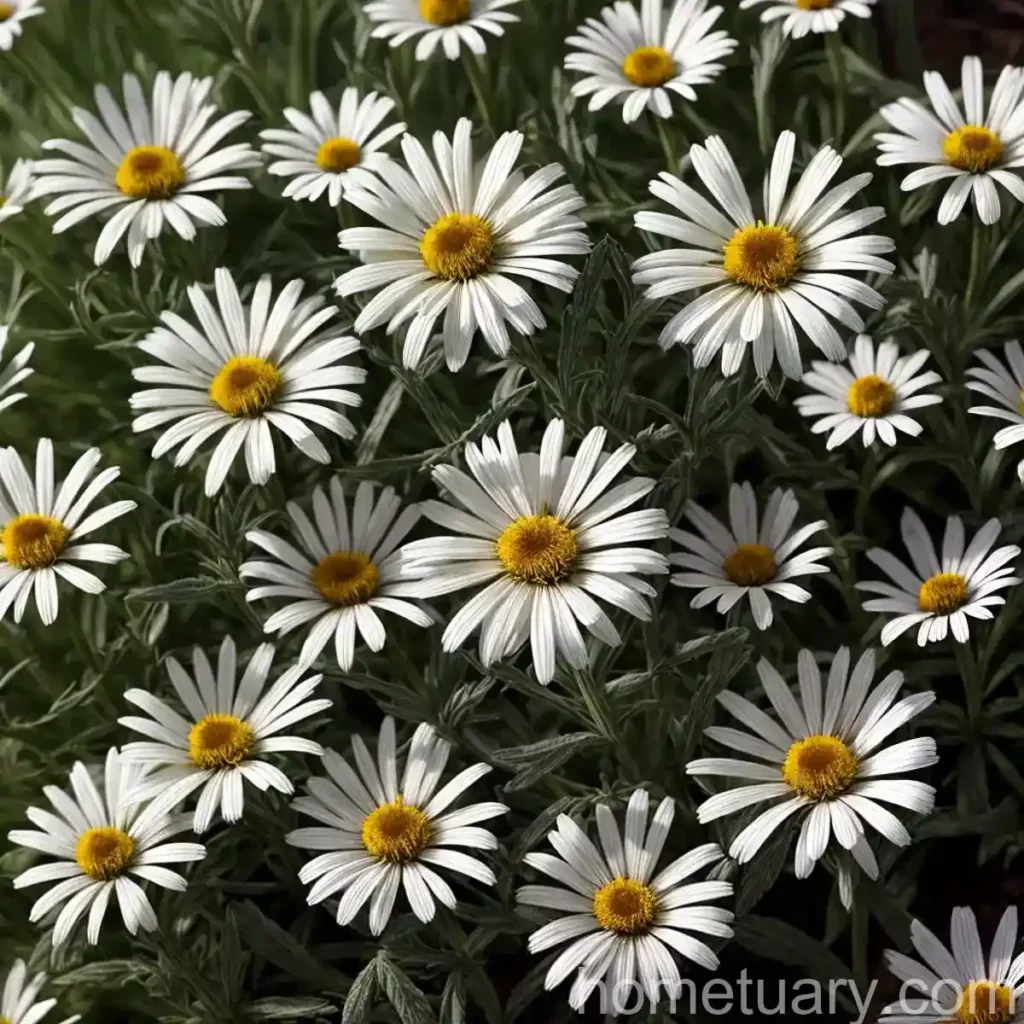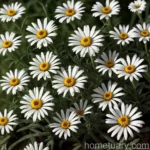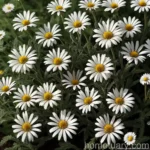Shasta Daisy (Leucanthemum x superbum ‘Real Dream’)
Shasta daisy (Leucanthemum x superbum ‘Real Dream’) is a beautiful and popular perennial flower in the daisy family Asteraceae. It is known for its large, white, and yellow-centered flowers that bloom profusely in the summer. This versatile plant is a favorite among gardeners due to its low maintenance requirements and ability to attract pollinators. In this comprehensive guide, we will explore the key aspects of Shasta daisy, including its culture, uses, care requirements, common diseases, pests, and propagation techniques.
What is Shasta Daisy?
Shasta daisy, scientifically known as Leucanthemum x superbum ‘Real Dream’, is a hybrid flower that was created by Luther Burbank in the 1890s. It is a cross between the Oxeye daisy (Leucanthemum vulgare) and the European field daisy (Leucanthemum maximum). This iconic perennial is characterized by its large, showy flowers, which typically measure 2 to 4 inches across. The blooms feature white petals and a bright yellow center, creating a classic daisy-like appearance.
Shasta daisies are valued for their long-lasting blooms, which make them an ideal addition to garden borders, containers, and cut flower arrangements. Their sturdy, upright stems and deep green foliage provide an attractive backdrop for the striking flowers, adding a touch of elegance to any landscape.
Key Takeaways – Shasta Daisy (Leucanthemum x superbum ‘Real Dream’)
Before delving into the specific aspects of Shasta daisy care and cultivation, let’s explore some key takeaways about this beloved perennial:
- Scientific Name: Leucanthemum x superbum ‘Real Dream’
- Family: Asteraceae
- Common Name: Shasta Daisy
- Flower Color: White with yellow center
- Plant Type: Herbaceous perennial
- Bloom Time: Summer to early fall
- Sunlight: Full sun to partial shade
- Watering: Moderate
- Soil Type: Well-draining, fertile soil
- Height: 18-24 inches
- Spread: 12-18 inches
- USDA Hardiness Zones: 5-9
Now that we have gained a general understanding of Shasta daisy, let’s delve into the specific aspects of its culture, uses, and care requirements.
Culture of Shasta Daisy
Uses
Shasta daisies have a wide range of uses in garden landscapes and floral arrangements. Some of the common applications of Shasta daisies include:
- Garden Borders: Shasta daisies are commonly used to create striking borders and edgings in garden beds. Their bright, white blooms add a refreshing and vibrant touch to the landscape.
- Cut Flower Arrangements: The long stems and enduring blooms of Shasta daisies make them a popular choice for cut flower arrangements. They add a touch of natural elegance to bouquets and floral displays.
- Pollinator Gardens: These flowers are valuable for attracting pollinators, such as bees and butterflies, making them an essential component of wildlife-friendly gardens.
Water
Shasta daisies thrive in moderately moist soil, so it is essential to provide them with regular watering, especially during dry spells. However, it is crucial to avoid overwatering, as excessive moisture can lead to root rot and other fungal diseases. A general rule of thumb is to provide about 1 inch of water per week, either through rainfall or manual irrigation.
Sunlight
In terms of sunlight requirements, Shasta daisies prefer full sun to partial shade. They should be planted in an area that receives at least 6 hours of direct sunlight each day. Insufficient sunlight may result in reduced flower production and weaker, leggy growth.
Fertilizer
When it comes to fertilization, Shasta daisies benefit from a balanced, slow-release fertilizer applied in early spring. This helps to promote healthy growth and abundant blooming throughout the growing season. Additionally, incorporating organic matter, such as compost, into the soil can provide essential nutrients and improve overall soil quality.
Soil
Shasta daisies thrive in well-draining, fertile soil. They prefer a slightly acidic to neutral pH range of 6.0-7.0. Amending the soil with organic matter, such as compost or well-rotted manure, can help improve its texture and fertility. It is important to ensure that the soil provides adequate aeration and drainage, as waterlogged conditions can be detrimental to the plants.
Pruning
Pruning is an essential aspect of Shasta daisy care, as it helps to maintain the plant’s shape, promote bushier growth, and prolong flowering. Deadheading, which involves removing spent blooms, encourages the development of new flowers and prevents the plants from diverting energy into seed production. Additionally, cutting back the foliage in late summer or early fall can help rejuvenate the plant and prepare it for the following growing season.
Propagation
Shasta daisies can be propagated through several methods, including division, stem cuttings, and seeds. Division is a popular technique whereby the plant is separated into smaller sections, each with their own roots and shoots. This is typically done in early spring or late summer to early fall. Stem cuttings involve taking a section of a stem with a node and encouraging it to develop roots in a suitable growing medium. Lastly, seeds can be collected from mature flowers and sown in a prepared seedbed or container.
Container Popularity
Shasta daisies are well-suited for container gardening, making them a versatile choice for individuals with limited gardening space. When grown in containers, they can be placed on patios, balconies, or porches to add a pop of color to outdoor living areas. Furthermore, container-grown Shasta daisies can be easily moved to optimize sunlight exposure and aesthetics in the garden.
Container Common Diseases
When cultivating Shasta daisies in containers, it is important to be mindful of potential diseases that may affect the plants. Some common container diseases that can impact Shasta daisies include:
- Root Rot: Excessive moisture in container soil can lead to root rot, a fungal disease that causes the roots to decay and the plant to wilt.
- Powdery Mildew: This fungal disease appears as a white powdery coating on the leaves and stems, affecting the plant’s ability to photosynthesize and thrive.
Disease Diagnosis
Diagnosing and addressing diseases in Shasta daisies is essential for maintaining plant health and preventing the spread of infections. When observing signs of disease, such as wilting, yellowing foliage, or unusual spots on the leaves, it is important to take prompt action. Proper diagnosis involves identifying the specific symptoms and consulting resources to accurately pinpoint the cause of the issue.
Common Pests
Like many ornamental plants, Shasta daisies can be susceptible to certain pests that may affect their growth and overall vitality. Some common pests that may target Shasta daisies include:
- Aphids: These small, soft-bodied insects feed on the sap of the plant, causing distorted growth and the development of sticky honeydew on the leaves.
- Slugs and Snails: These pests can feed on the foliage and flowers of Shasta daisies, leaving behind irregular holes and damage.
Botanist’s Tips
To ensure the successful cultivation of Shasta daisies and maximize their ornamental value, consider the following botanist’s tips:
- Mulching: Applying a layer of organic mulch around the base of Shasta daisies can help conserve soil moisture, suppress weed growth, and insulate the roots from temperature fluctuations.
- Supporting Stems: In areas with strong winds or heavy rainfall, providing support for the tall stems of Shasta daisies can prevent them from bending or breaking, especially when they are in full bloom.
- Regular Inspection: Conducting regular inspections of the plants for signs of disease, pests, or nutrient deficiencies can help address issues proactively and maintain plant vigor.
Fun Facts
- Shasta daisies are named after the snow-capped Mount Shasta in Northern California, where Luther Burbank first developed this hybrid flower.
- The word “Leucanthemum” is derived from the Greek words “leukos” (white) and “anthemon” (flower), referring to the predominantly white blooms of the plant.
- In addition to their ornamental value, Shasta daisies are sometimes used in herbal medicine for their purported healing properties, although this should be approached with caution and expert guidance.
Links to External Resources
For further information on Shasta daisy cultivation, care, and landscaping ideas, you may find the following links helpful:
- The National Gardening Association
- The Old Farmer’s Almanac – Shasta Daisy Growing Guide
- North Carolina State University Extension – Shasta Daisy Production Guide
- Missouri Botanical Garden – Leucanthemum x superbum ‘Real Dream’
In conclusion, Shasta daisy (Leucanthemum x superbum ‘Real Dream’) is a resilient and captivating perennial plant that adds grace and charm to garden landscapes. With proper care and attention to its cultural requirements, Shasta daisy can thrive and delight gardeners with its abundant, cheerful blooms. Whether used as a border plant, a cut flower, or a pollinator attractor, this timeless flower continues to be cherished for its enduring beauty and adaptability.
By incorporating the insights and tips presented in this guide, gardeners can cultivate healthy and vibrant Shasta daisies, creating picturesque displays that brighten outdoor spaces and bring joy to all who encounter them.
Remember, successful gardening is a journey of learning and discovery, and every effort made to nurture these beautiful plants will be rewarded with the enduring splendor of Shasta daisies in full bloom.
Keywords: Shasta daisy varieties, Real Dream shasta daisy, Leucanthemum x superbum ‘Real Dream’, Shasta daisy care tips, Growing shasta daisies, Shasta daisies in gardens, Perennial shasta daisy, Shasta daisy plant information, Real Dream daisies, Leucanthemum x superbum cultivation, Shasta daisies for landscaping, Shasta daisy plant care, Shasta daisy characteristics, Shasta daisy companion plants, Real Dream daisy varieties, Leucanthemum x superbum ‘Real Dream’ features, Shasta daisy flowering season, Shasta daisy landscaping ideas, Real Dream daisy cultivation, Leucanthemum x superbum ‘Real Dream’ growing tips, Shasta daisy garden design, Shasta daisy perennial flower, Real Dream shasta daisy characteristics, Leucanthemum x superbum ‘Real Dream’ maintenance, Shasta daisy plant propagation, Shasta daisy planting guide, Real Dream daisy care instructions, Leucanthemum x superbum features, Shasta daisy garden maintenance, Shasta daisy pruning tips, Real Dream shasta daisy varieties, Leucanthemum x superbum ‘Real Dream’ landscape uses, Shasta daisy pest management, Shasta daisy watering needs, Real Dream daisy landscaping uses, Leucanthemum x superbum ‘Real Dream’ soil requirements, Shasta daisy container gardening, Shasta daisy companion gardening, Real Dream shasta daisy planting season, Leucanthemum x superbum ‘Real Dream’ sun requirements, Shasta daisy naturalizing techniques, Shasta daisy fertilization tips, Real Dream daisy mixed flower beds, Leucanthemum x superbum ‘Real Dream’ disease resistance, Shasta daisy attracting pollinators, Shasta daisy drought tolerance, Real Dream shasta daisy pruning techniques, Leucanthemum x superbum ‘Real Dream’ bloom duration, Shasta daisy winter care, Shasta daisy division techniques















